By Jess Kimmel ’25
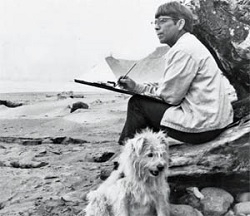
Ruth Dennis Grover on a beach in Road’s End, Oregon, from Notable Women of
Portland, by Tracy Prince and Zadie Schaffer. Photographer unknown.
In the 1st Century BCE, Julius Caesar purchased a pair of encaustic paintings from a Greek artist for the extraordinary sum of 80 talents apiece (over $4 million in today’s money!)1. These early paintings, originating in Egypt prior to the 5th Century BCE, were highly valued in Greek and Roman civilization, and are believed to be one of the earliest painting techniques in recorded history. Due to the extreme difficulty of producing encaustics, the form had fallen out of style by the Renaissance with the advent of oil painting, and only a select few artists continued to work with it. Many centuries later, an Oregonian painter named Ruth Dennis Grover would be influential in introducing the encaustic style to the Pacific Northwest.
Ruth Dennis Grover was born in Portland in 1912 and raised in Detroit. After graduating with honors from the University of Michigan, she returned to Oregon, where she spent the rest of her life living in what is now Lincoln City. She had a lifelong interest in rocks and minerals, particularly agates, and was a self-proclaimed “rockhound” (rock collector). In 1952, she founded Cascade Artists, a small society of Oregon watercolor artists that held many exhibitions throughout the state. Grover herself was also a part of the Oregon Society of Artists. Though initially known for her work with watercolor, she discovered encaustics in 1956 and began to research and experiment with the technique. According to Grover, encaustics became a “consuming interest”, as well as a “technical [and] artistic challenge”.
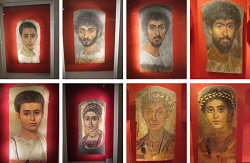
The Fayyum mummy portraits, some of the earliest and most well-known examples of encaustics. Photos taken by Ruth Maude at the Metropolitan
Museum of Art in New York.
As for the form itself, encaustic paintings are made by combining paint pigment with refined beeswax and resin, and using heat (at highly precise temperatures) to seal the paint in layers, resulting in “exceptional luminosity” and a permanency unmatched by any other style of painting. “It is impervious to the chemical changes that cause other media to yellow, crack, or fade with time,” Grover writes in an introductory paper on encaustics. Even sunlight does not have the same fading effect on encaustics that it does with many other mediums. The Fayyum portraits, which are among the most famous surviving examples of the encaustic medium, were painted around two thousand years, yet their colors are still just as vibrant now as at the time of their creation. The name is derived from the Greek word “enkaustos”, which means “burnt in”. Modern technology makes this form much more accessible and feasible to create, though it is still dangerous and requires painstaking precision.
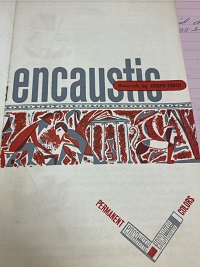
The cover of the Joseph Torch pamphlet, found in Box 3, Folder 7, of the Ruth Dennis Grover papers in the Willamette University Archives.
According to a pamphlet published by Joseph Torch, an art materials store in New York, encaustic painting was nearly unheard of in the Americas before the 1950s, and it was only at the urging of a European painter that Joseph Torch began to do research into the medium and stock materials for encaustics. It was here that Ruth Dennis Grover first purchased the materials for her early encaustic paintings.
Grover’s work is described as “semi-abstract”, with a focus on naturally occurring patterns and the exploration of “spatial, textural, and color relationships”. Much of her inspiration was drawn from the Oregon Coast, and a significant amount of her work consists of seascapes, lighthouses, and shipwrecks. Grover believed that encaustics were well-suited for marine paintings, due to their flexibility and diverse expressibility. “Natural forces,” she notes, “express their existence not in themselves, but in the things they move and shape.
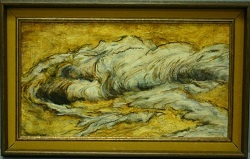
“The Second Sea”, one of Grover’s encaustic marine paintings, held in the Hallie Ford Museum of Art. Dated 1967.
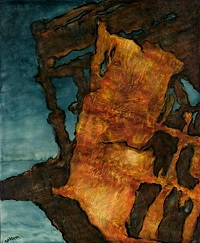
“Tooth of Time and Razure of Oblivion”, another encaustic painting by Grover, depicting a piece of a shipwreck. Held in the Hallie Ford Museum of Art. Dated 1968.
Though Ruth Dennis Grover passed away in 2003, her legacy lives on in the communities of PNW artists that she had a hand in creating, as well as the paintings she forged with fire; paintings that will never fade, forever serving as a memory of the artist, and the ancient medium that she mastered. Many of her works are held by the Oregon Historical Society, the Coos Art Museum, and the Hallie Ford Museum of Art. Furthermore, the Willamette University Archives contain a vast collection of records from her life and work, including photographs, correspondence, exhibitions, and artistic journals, as a part of the Pacific Northwest Artist’s Archive.
Footnotes
1. Adjusted for inflation: Grover’s notes from the 1950s mention a figure of $350,000
Sources
Interviews, notes, 1931-1966, Series II, Box: 3, Folder: 2. Ruth Dennis Grover papers,
WUA052. Willamette University Archives and Special Collections.
Paint supplies, ordering notes and receipts, 1958-1996, Series II, Box: 3, Folder: 7. Ruth
Dennis Grover papers, WUA052. Willamette University Archives and Special
Collections.
Maude, Ruth. “The History of Encaustic Painting from Fayum Funeral Portraits to
Today.” All Things Encaustic, https://allthingsencaustic.com/introduction-encaustic/.
Accessed 24 Oct. 2022.
Online Collections | Hallie Ford Museum of Art – Willamette University.
willametteart.pastperfectonline.com. Accessed 24 Oct. 2022.
Vitae Statements, Introductions, undated, Series II, Box: 3, Folder: 3. Ruth Dennis
Grover papers, WUA052. Willamette University Archives and Special Collections.
